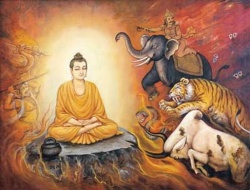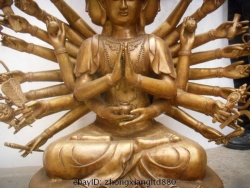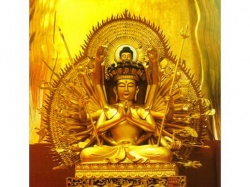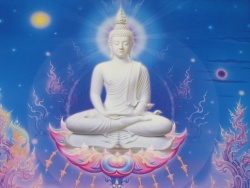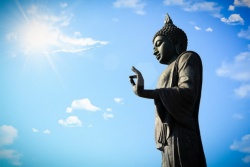The 25 States of Existence
The Brahmanic scheme of the 25 states of existence elaborates on and helps clarify these six spiritual realms, the threefold realm of sensory desire, form & formlessness and the realms of heaven.
The 25 States of Existence are divided as follows:
- A. Four lower destinies
- B. Four humans races
- C. Six heavens in the realm of desire
- D. Seven heavens in the realm of form
- E. Four heavens in the realm of formlessness
A. #1-#4 The four lower destinies
- 1 Hell - Suffering (Naraka-gati)
- 2 Brutality - Animals (Tiryagyoni-gati)
- 3 Hunger - Ghosts (Preta-gati)
- 4 Demons - Competitive Egos (Asura-gati)
B. #5-#8 Humans of the four continents - The four continents or 'quarters under heaven' surround Mt. Sumerue great central mountain that reaches up into the realm of heaven. Mt. Sumeru was of course the Himalayas which were, to the Aryans of the Vedas and the brahmanic period, literally in heaven. The four different races of humans, as understood by ancient India, resided in the four continents below:
- 5 Jambudvipa, to the south: Named after the Jambu tree with its large, triangular leaves that symbolize the Indian subcontinent. Jambudvipa was later used generally for all of humanity.
- 6 Purva-Videha, to the east, semi-circular in shape, the ‘continent of conquering spirits’, where the people have faces of similar (semi-circular) shape (East Asia, the Pacific Rim)
- 7 Apara-Godana, to the west, ‘where oxen are used as money’, circular in shape, and faces of the people are circular in shape (Persia, Middle East)
- 8 Uttara-Kuru, to the north, square in shape where the people have square faces. Called 'The high country', because of the mountains (modern Tibet, Afghanistan, Central Asia)
C. #9-#14 The Six Heavens in the Realm of Desire, where the gods with sensory desire reside above Mt. Sumeru:
- 9 The Heaven of the Four Divine Kings: The arms of heaven; the four generals of Sakra Devendra (Indra) who guard heaven from the four lower destinies
- 10 The Heaven of the 33 Gods (S. Trayastrimsas); Its lord is Sakra Devendra (Indra), wielder of the thunderbolt who personifies the power and mastery of the self (the will of heaven). Lord of the secular world, he resides atop Mt. Sumeru with his palace in the City of Beautiful Views (Sudarsana). There are 32 Gods who report to him on the good & evil done in the world. These 32 Gods are the rulers of our higher natures as gods in this world. These 32 are divided into:
- 11 The Suyama Heaven, Its lord is Yama, the god and judge of purgatory & the afterlife; the realm of repentance, atonement
- 12 The Tusita Heaven, the heaven of contentment; the future Bodhisattvas and Buddhas dwell in it prior to entry into the womb that leads to this Saha (endured) world; the realm of rebirth, rejuvenation
- 12 The Sunirmita Heaven, heaven of pleasant transformations: where the gods create their own pleasures and where every pleasure is attainable at will. It is the realm where one's own desires are mastered.
- 14 The Paranirmita Vasavartin Heaven, the abode of Mara, the lord and master of the desire of others, using the power of desire to control others; the heaven where one avails oneself of the merits of others for one’s own pleasure, making others obedient to one’s will; the devil - lord over lust, sin & death.
D. #15-#21 The Seven Heavens of Form - This realm is purified of sensory desire. There is still material form, the six sense faculties and the six sensations, but being pure of sensory desire one enters into progressively deeper meditative states known as the four basic meditations.
- 15 The Great Brahma Heaven - Brahma is the lord of the religious world, and the only god beyond & pure of the Realm of Sensory Desire. The realm of heaven where there is purity of heart, sincerity of faith, and devotion.
- 16 - #19 The Four Heavens of Meditation - Also known as The Brahma Heavens - The fours basic levels of meditation are in the realm of form, pure of the distractions of sensory desire, in which one sequentially sublimates the senses. Each progressive level is an ever more pure state of Samadhi (mental concentration). There are eighteen Brahma Heavens that are distinguished.:
- 16 - The First Dhyana Heavens (The Heavens of Brahma):
- A. Followers of Brahma (Brahmaparisadya)
- B. Assistants of Brahma (Brahma-purohita or Brahma-kayika)
- C. The Great Brahma (Maha Brahma)
- 17 - The Second Dhyana Heavens (The Heavens of Light):
- A. A Measure of Light (Parittabha)
- B. Measureless Light (Apramanabha)
- C. Light & Sound (Abhasvara)
- 18 - The Third Dhyana Heavens (The Heavens of Purity):
- A. A Measure of Purity (Parittasubha)
- B. Measureless Purity (Apramanasubha)
- C. Purity Everywhere (Subhakritsna)
- 19 - The Fourth Dhyana Heavens (The Highest Heaven):
- A. Without any Clouds (Anabhraka)
- B. Birth into Blessings (Punyaprasava)
- C. Producing Great Fruits (Brihatphala)
- 20 - The Heaven Beyond Thoughts - the next stage of the fourth dhyana heaven
- D. Beyond Thoughts (Asanjnisatva)
- 21 - The Five Pure Abodes of Heaven: The last stages of the fourth dhyana heaven.
E. #22 - #25 The Four Heavens in the Realm of Formlessness: The next four realms are formless, where the limitations of the body and the plurality or multiplicity of physical objects is transcended. One is emancipated from the limitations of the senses and the physical realm and enters into:
- 1 The boundlessness of empty space
- 2 The boundlessness of consciousness
- 3 The boundlessness of nothingness
- 4 The boundlessness of that which is neither with nor without perception

